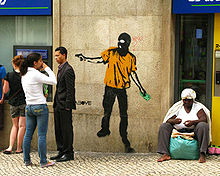Artivism

Artivism is a portmanteau word combining art and activism.
Artivism takes roots, or branches, off of a 1997 gathering between Chicano artists from East Los Angeles and the Zapatistas in Chiapas, Mexico. The words "Artivist" and "Artivism" were popularized through a variety of events, actions and artworks via artists and musicians such as Quetzal, Ozomatli, and Mujeres de Maiz, among other East Los Angeles artists, and at spaces such as Self Help Graphics & Art.
Artivism developed in recent years as antiwar and anti-globalization protests emerged and proliferated. In many cases artivists attempt to push political agendas by the means of art, but a focus on raising social, environmental, and technical awareness is also common. Besides using traditional mediums like film and music to raise awareness or push for change, an artivist can also be involved in culture jamming, subvertising, street art, spoken word, protesting, and activism.[1][2][3]
Artivist Eve Ensler stated:
... This passion has all the ingredients of activism, but is charged with the wild creations of art. Artivism—where edges are pushed, imagination is freed, and a new language emerges altogether." Bruce Lyons has written: "... artivism ... promotes the essential understanding that ... [humans] ... can, through courageous creative expression, experience the unifying power of love when courage harnesses itself to the task of art + social responsibility.[1][2][3]



By 2008, the term had made its way into academic writing, with Chela Sandoval and Guisela Latorre publishing a piece on Chicano/a artivism and M. K. Asante using the term in reference to Black artists.[4][5]
There is a chapter on artivism in the book It's Bigger Than Hip Hop by M. K. Asante. Asante writes of the artivist:
The artivist (artist + activist) uses her artistic talents to fight and struggle against injustice and oppression—by any medium necessary. The artivist merges commitment to freedom and justice with the pen, the lens, the brush, the voice, the body, and the imagination. The artivist knows that to make an observation is to have an obligation.
The impact of artivism vs. conventional activism was tested in a public scientific experiment in Copenhagen, Denmark, in 2018. The results, reported in the journal of Social Movement Studies, suggest that artivism may be more effective than conventional activism.[6]
Artivists[]
- Above
- Ai Weiwei
- Gianluca Costantini
- Aloe Blacc
- Annie Sprinkle
- Anomie Belle
- Banksy
- Bleepsgr
- Daniel Arzola (Spanish)
- Deborah De Robertis
- Deeyah Khan
- Ernest Zacharevic
- Favianna Rodriguez
- Guillermo Gómez-Pe��a
- [7][8][9][10][11][12]
- JoFF Rae
- JR
- Jeanmarie Simpson
- Judy Baca
- Julio Salgado
- Las Cafeteras
- Lila Downs
- Lost Children of Babylon
- Lydia Canaan
- Lynnette Haozous
- Martha Gonzalez
- Martin Aveling
- Maya Jupiter
- Michel Platnic
- Milo Moiré
- Norm Magnusson
- Pavel 183
- Peter Joseph
- Quetzal (band)
- Reverend Billy and the Church of Stop Shopping
- Self Help Graphics & Art
- Tania Bruguera
- Tinkebell
- Valie Export
- Will St Leger
Collectives and organizations[]
- Artivist Film Festival
- Crass
- Da! collective
- Pangaeseed Foundation
- Red Rebel Brigade
- The Fearless Collective
- The Yes Men
- Sol Collective
See also[]
- The arts and politics
- Invisible theater
- Social center
- Timeline of Extinction Rebellion actions
- Whirl-Mart
References[]
- ^ a b Politics, Power and Passion, The New York Times, December 2, 2011. Please see the fifth segment by Eve Ensler.
- ^ a b Jeanmarie Simpson -- Artivist in the Modern Landscape (Part 1), Dylan Brody, The Huffington Post, 2011.10.03
- ^ a b Jeanmarie Simpson -- Artivist in the Modern Landscape (Part 2), Dylan Brody, The Huffington Post, 2011.10.05
- ^ Chela Sandoval and Guisela Latorre, ""Chicana/o Artivism: Judy Baca's Digital Work with Youth of Color," in Learning Race and Ethnicity, MIT Press, 2007.
- ^ M.K. Asante, Jr. It's Bigger Than Hip Hop, St. Martin's Press, 2009.
- ^ Stephen Duncombe & Silas Harrebye (2021) The Copenhagen Experiment: testing the effectiveness of creative vs. conventional forms of activism, Social Movement Studies, DOI: 10.1080/14742837.2021.1967125
- ^ In wake of Trump's DACA decision, L.A.'s Self-Help Graphics Los Angeles Times, September 7, 2017. By Carolina Miranda
- ^ Self Help Graphics project empowers day laborers through art Los Angeles Times, April 4, 2017. By Carolina Miranda
- ^ A World Series Trans Pride Banner Drop Gave the TransLatin@ Coalition a Chance to Raise Its Voice Teen Vogue, October 29, 2018. By Kaylen Ralph
- ^ COLUMBUS COMES DOWN: HOW A 'SYMBOL OF ATROCITY' FINALLY BECAME A MOMENT OF HEALING , November 10, 2018. By
- ^ Why L.A. protesters took down a Junipero Serra statue Los Angeles Times, June 20, 2020. By Carolina Miranda
- ^ Goodbye, guy on horse: After monument topplings, new... Los Angeles Times, July 23, 2020. By Carolina Miranda
- Contemporary art
- Activism
- Culture jamming
- Political art
- DIY culture